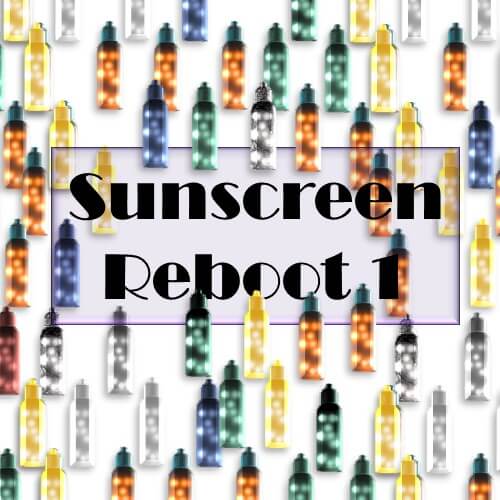It’s six months since I penned my first blog. I’m totally up for a Charlie Brown & Co party.

I have made progress, as many folks email or ask me about sunscreen. Common themes are:
“This UVA and UVB is too confusing.” “I bought sunscreen, why do I have to read the Ingredient label?” “You are Indian and you won’t get skin cancer – don’t waste money on sunscreen.”
My next few blogs are revisiting sunscreen basics.
In fact, my hope is that if an alien with no knowledge of Earth (or ok, Rahul Gandhi) reads this and understands WHY they need to wear sunscreen EVERY day, I will have succeeded.
The “Suncreen reboot” features:
- What damage is sunscreen preventing?
- Why you should read the Ingredient label of sunscreens
- What to look for on the Ingredient label of sunscreens
Without any further delay, (drum roll please), here we go….
1) What is Ultraviolet Radiation?
The sun’s radiation is made up of: Infra Red (IR), Visible light and Ultra Violet Radiation (UVR). Some products claim that IR and Visible light cause adverse skin effects. The scientific evidence behind such products is questionable. Moving on…
Ultraviolet radiation: UVR = UVC (ignore) + UVB + UVA
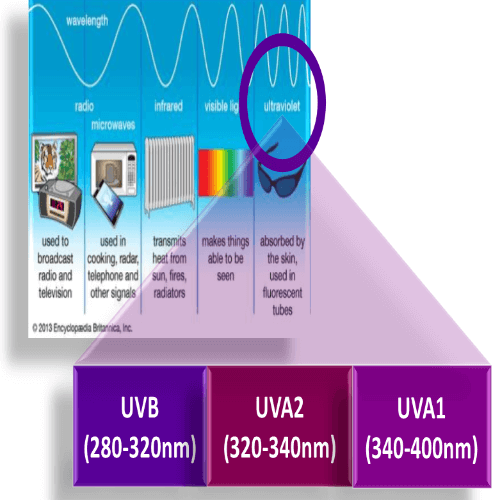
UVB (280-320nm) is the shorter and higher energy radiation and about 5% reaches us.
UVA (320-400nm) is less energetic, but about 95% of UVR reaching us is UVA. UVA is made of UVA2 and UVA1. Most of UVR is UVA1.
Factors that affect the intensity of UVR are:
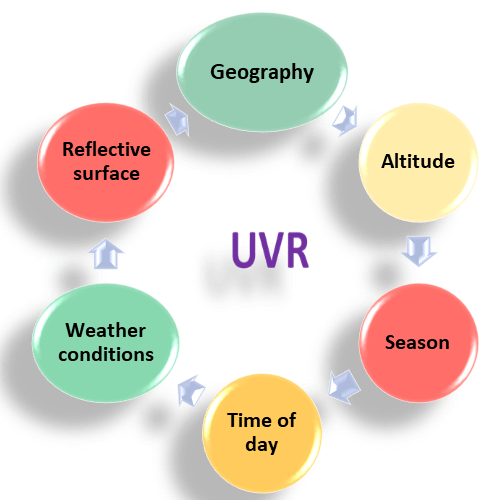
- Geography: UVR is most intense near the equator, as the sun is directly over the equator and has a short distance to travel.
- Altitude: Higher altitudes have greater UVR exposure as the atmosphere is much thinner and so more UVR reaches the earth’s surface.
- Time of the year: The earth is closer to the sun during the summer and more UVR reaches the earth’s surface then.
- Time of the day: UVR is most intense at mid-day when the sun is directly above us and UVR has the shortest distance to travel.
- Weather conditions: UVR penetrates cloud cover.
- Reflection: Surfaces such as snow, sand, water and grass reflect UVR, which hits us if we are not wearing adequate sun protection.
There are not many UVA monitoring sites across the global. However, I found an Austrian funded study that has been measuring UVA and 2 findings stood out:
- UVA increases with altitude – the researchers found an increase of 8%-9% per 1,000m.
- During the first half of the year, UVA is higher in (Vienna) as there is lower cloud cover, than when compared to the second half of the year.
2) How do UVA and UVB react with our bodies?
UVB only penetrates the EPIDERMIS (top layer of our skin, that’s only 4-5 cells thick with no blood circulation) and part of the DERMIS (layer below).
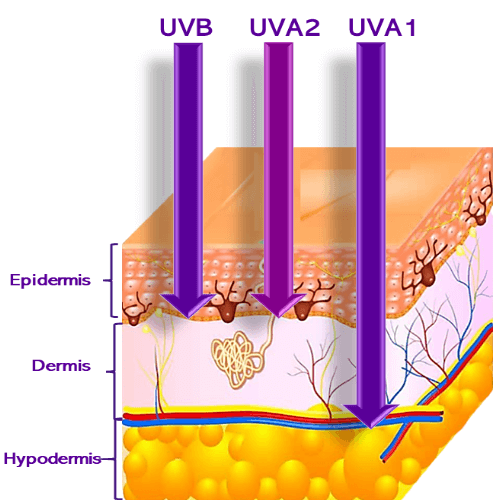
UVA is a longer wavelength radiation and it goes right down to the dermis and skims the hypodermis (where the fat stays). The dermis includes COLLAGEN fibres whose primary function is to give skin its structure and strength. Collagen also binds water to keep the skin hydrated.
Trust me, you don’t to accelerate collagen breakdown.
The key takeaway here is that UVB and UVA have different biological effects on us.
3) Detrimental effect of UVA and UVB
For a long time, UVB has been associated with sunburn and skin cancer. A sunburn (or inflammation of the skin) results from reddening of the skin (erythema), when skin is over-exposed to UVB. Over a similar period, UVA has been associated with photoaging, especially because sun damage is cumulative. I found one study that suggests that along with smoking, UV radiation accounts for over 80% of facial aging.
I cannot emphasize enough, that now BOTH UVA and UVB have been implicated in:
- Skin cancer (UVR, including UVA and UVB is a recognized carcinogen).
- Photoaging
- Immuno-suppression
- Cataracts
This is important for 2 reasons. Its vital to find sunscreens that protect against both UVA and UVB damage. Second, sun damage is cumulative -see the diagram below, and you really should not be waiting till your 40 to start slapping on sunscreen.
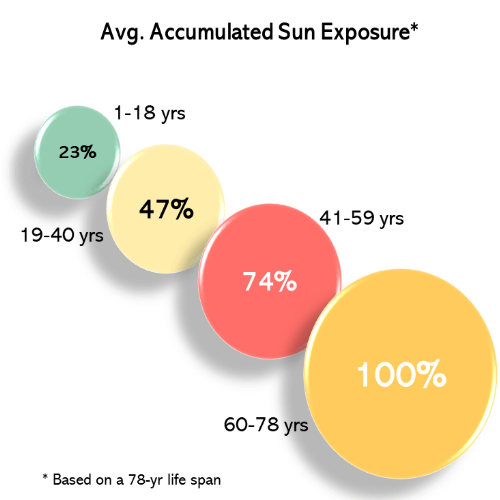
3a) Mechanism of action of UVA and UVB
Higher energy UVB mainly causes sun burn (or inflammation of the skin) resulting from reddening of the skin (erythema).
Premature ageing (or photoaging) caused by UVA is through the generation of Reactive Oxygen Species (ROS), which essentially causes the breakdown of collagen in our skin. Collagen is what gives skin its structure and resilience. Premature ageing is characterised by hyperpigmentation, wrinkle and loss of skin elasticity and so on.
Hyper-pigmentation and tanning are also mainly caused by UVA.
Both UVA and UVB negatively impact the body’s immune system. Its also possible for the skin on your eyes to burn – causing inflammation and on a long-term basis, cataracts, which globally is a major source of blindness.
2) What does sunscreen have to do with UVR?
Regular use of sunscreen reduces the risk of skin cancer and photo-ageing. According to the skin cancer foundation, regular use of an SPF 15 or higher sunscreen:
- in individuals using this on a daily basis, shows 24 percent less skin aging than those that do not use sunscreen daily
- reduces the risk of developing melanoma by 50 per cent.
What happens if you don’t use the correct quantity of sunscreen
Studies show:
- Individuals use less than the recommended amount to cover an average sized adult:
- 2mg/cm2
- 6-9 teaspoons OR
- 1.3oz – 1.6oz OR
- 36-45 grams.
- Reducing sunscreen by even 50% reduces the sun protection by two-thirds. For example, instead of an SPF 30 product, your actual protection is SPF 10….
What happens if you use the wrong sunscreen?
There are many sunscreen products in India and the US that offer strong UVB protection, but lack UVA protection. Such a product causes excessive accumulation of UVA doses – especially with children, who have a higher skin surface to weight ratio. This simply increases the risk of skin cancer and early skin aging.
3) Why should you be using sunscreen?
When Indians ask me WHY they should be using sunscreen. I will readily admit that skin cancer should not be of great concern to the vast majority of Indians.
Dark skin has a skin pigment – eumelanin (dark brown pigment) – that is thought to give darker skin better protection against UVR than fair skin.
But UVA (which causes premature aging) applies to all skin types.
Indians need to use sunscreen because our skin is not UVR resistant. Indians are not resistant to photoaging, immunosuppression and cataracts. The collagen in our skin breaks down and importantly, we get hyper-pigmentation and we “tan” – which is UVR damage.
Sunscreen reduces these effects.
So, if you don’t want to prematurely age, please use sunscreen.
Please drop me a line at email@happyskindays.com if you have any questions or comments.
Other posts you maybe interested in are
Myths about sun-protection, How to buy sunscreen
Sources and Uses
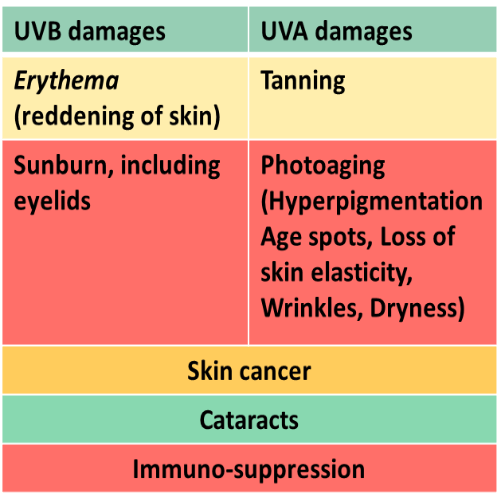
Green AC, Williams GM, Logan V, Strutton GM. Reduced melanoma after regular sunscreen use: randomized trial follow-up. J Clin Oncol 2011; 29(3):257-263.
Comparison of ultraviolet A light protection standards in the United States and European Union through in vitro measurements of commercially available sunscreens
https://www.who.int/uv/faq/uvhealtfac/en/index2.html
Michaela Brenner and Vincent J. Hearing The Protective Role of Melanin Against UV Damage in Human Skin Photochemistry and Photobiology, 2008, 84: 539–549
Schmalwieser, Alois W et al. “The Austrian UVA-Network.” Photochemistry and photobiology (2019)
